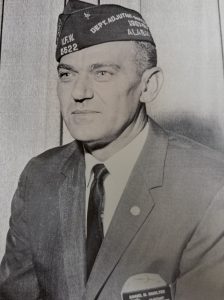Samuel Marlin Hamilton was born to William Richard “Bud” Hamilton and wife Mary Edna “Mollie” Woodham on Sep 15, 1922, in the Wiggins Community, near Sanford, AL. The family moved to Opp in 1936.
Hamilton graduated from Opp High School in the Class of 1940 and enrolled at the University of Alabama in the fall. His education was short lived when WWII broke out after the Japanese bombing of Pearl Harbor. Like so many others, he joined the military shortly after December 7, 1941, a surprise attack.
Hamilton signed up as an Aviation Cadet on Feb. 1, 1942. He trained at Maxwell Field, Greenwood Mississippi, and other locations before getting his aviation wings and receiving a commission as second lieutenant on March 12, 1944, at Stewart Airfield, N.Y. After further training in the B-24 Liberator bomber, he was assigned to the 763d Squadron of the 460th Bombardment Group in Italy.
As part of the 15th Air Force, the mission of the 460th Group was to destroy bridges, oil refineries, factories, airdromes and other strategic enemy targets in Germany, France, Austria and Hungary.
Lieutenant Hamilton flew 7 successful combat missions, was promoted to first lieutenant on Nov 7, and was flying lead plane on his 8th bombing mission on Nov 16, 1944, when his formation was attacked by German fighter planes 4 hours into a bombing mission over Munich. His plane was heavily damaged, and the crew was forced to bail out over the Blue Danube Valley near Berchtesgaden, Austria. German ground forces captured the men two hours later, and one of Hamilton’s crewmen was killed with 6 others were wounded in the capture.
The POWs were taken on a winding trek by foot and railroad car via Salzburg, Stuttgart and Frankfurt to Dulag Luft for interrogation and finally to Stalag I, a prisoner of war camp near Barth, Germany, 104 miles north of Berlin on the Baltic Sea.
Stalag I housed approximately 9,000 allied prisoners of war until the camp was abandoned by the Germans and was liberated by Russian troops on May 2, 1945. Almost 8000 Americans were in the camp. Notables at Stalag 1 included fighter pilot Colonel Herbert “Hub” Zemke that Jimmy Doolittle called our greatest fighter group commander; Bob Hoover, aviator who after the war became America’s greatest acrobatic showman at air shows; and John C Morgan, a British Royal Air Force pilot who also flew with the Americans and was awarded the Medal of Honor. All in all, Hamilton was one of 95,532 POWS in Europe.
As the Russians and Americans closed in, Germany abandoned the camp on 29 April 1945. Hamilton was freed and flown back to bases in France and on to Camp Lucky Strike at Le Havre, from where the men departed for home.
He returned to the U.S. aboard the hospital ship USS Monticello.
Back in Alabama on June 5, 1945, and after promotion to captain, he was awarded the Purple Heart, Air Medal, Italian Campaign Medal and Distinguished Flying Cross.
Following his return, a collection of Hamilton’s war memorabilia was put on display at Air University schools at Maxwell AFB. Items included his uniforms and the key to the Stalag 1 prison camp that he had spirited out when the Russians freed him. There is also a plague in Opp commemorating his service to the community.
Hamilton went back to the Capstone and completed a degree in Geology at the University of Alabama in 1948. He then joined an uncle in the insurance and real estate business in Opp and later went into business for himself.
Hamilton worked tirelessly for Alabama Veterans of Foreign Wars from 1967-73 and was Veterans Coordinator at MacArthur Tech in Opp (now Lurleen B. Wallace) from Aug 1, 1973, to his Oct 31, 1982 retirement. Civic minded, Hamilton was also a Scoutmaster, he taught night Mathematics classes to Veterans and community adults and was a member of the Opp Lions Club. In recognition of his outstanding service to military veterans, he was awarded a Distinguished Service Medal from VFW National HQ in 1973.
Hamilton was very fond of working to beautify Opp, and he spent several years planting dogwood trees and other plants, even walking along the streets watering them during dry spells. A monument has been erected in downtown Opp honoring him for his efforts. Hamilton died March 3, 1987, and is buried in Hickory Grove Church Cemetery, along U.S. Highway west of Opp. He was inducted into the Hall of Fame in 2015.

